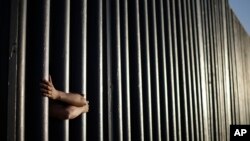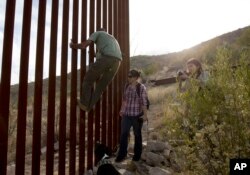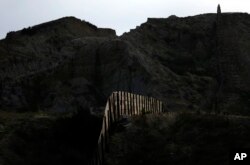One potential bidder on President Donald Trump's border wall with Mexico wanted to know if authorities would rush to help if workers came under “hostile attack.” Another asked if employees can carry firearms in states with strict gun control laws and if the government would indemnify them for using deadly force.
With bids due Tuesday on the first design contracts, interested companies are preparing for the worst if they get the potentially lucrative job.
A U.S. official with knowledge of the plans who spoke on condition of anonymity because the details haven't been made public said four to 10 bidders are expected to be chosen to build prototypes.
Prototypes to be built in San Diego
They will be constructed on a roughly quarter-mile (400-meter) strip of federally owned land in San Diego within 120 feet (37 meters) of the border, though a final decision has not been made on the precise spot, the official said. The government anticipates spending $200,000 to $500,000 on each prototype.
The Border Patrol and local police would establish a buffer zone around the construction site if necessary, the U.S. official said. The San Diego police and sheriff's departments said Monday they will respect constitutional rights to free speech and assembly for any peaceful, law-abiding protesters.
Enrique Morones, executive director of Border Angels, said his group plans to protest.
“There will be a lot of different activity — protests, prayer vigils — on both sides of the wall,” said Morones, whose immigrant advocacy group is based in San Diego. “We pray and hope that they're peaceful.”
Michael Evangelista-Ysasaga, chief executive of The Penna Group LLC, a general contractor in Fort Worth, Texas, said he has received about a dozen death threats since publicly expressing interest in bidding, including one from a woman who told him she hired a private investigator to trail him.
Evangelista-Ysasaga said he bid in part because he wants broad immigration reform. Securing the border, he said, is a prerequisite for granting a path to citizenship to millions in the U.S. illegally.
“We didn't enter this lightly,” he said. “We looked at it and said we have to be a productive part of the solution.”
Wall part of Trump's campaign
Building a wall on the Mexican border was a cornerstone of Trump's presidential campaign and a flashpoint for his detractors.
The multibillion-dollar project along the 2,000-mile border has many outspoken critics, including the Roman Catholic Archdiocese of Mexico, which said last week that Mexican companies expressing interest were betraying their country.
U.S. Customs and Border Protection said in a statement that it would pick multiple contractors to build prototypes by around June 1 and will name only the winning bidders. The agency said last month that the prototypes should be about 30 feet (9 meters) long and 18 to 30 feet (5.5 to 9 meters) high.
Security plan part of the bid
The winning bidders must submit a security plan with details including “fall back positions, evacuation routines and methods, muster area, medical staff members/availability, number of security personnel, qualifications, years of experience, etc. in the event of a hostile attack,” according to the solicitation. A chain-link fence with barbed wire around the construction site is required. The agency said it won't provide security.
Bidders are also asked to demonstrate experience “executing high-profile, high-visibility and politically contentious” projects.
The agency, responding to questions from companies on a website for government contractors, said the Border Patrol would respond as needed if there is a hostile attack, but companies were responsible for security. The government won't allow waivers from state gun laws or indemnify companies whose workers use deadly force.
Over 200 companies show interest
The website for contractors lists more than 200 companies that signed up for email notifications on the design contract but it's unclear how many of those will apply. Bidders must have done border security or similar projects worth $25 million in the past five years to qualify.
Ronald Colburn, Border Patrol deputy chief when hundreds of miles of fences were built under President George W. Bush's administration, said companies should plan on training workers to know when to seek cover and stay put and when to retreat.
“Most of those organizations are probably fairly accustomed to that,” said Colburn, who retired in 2009. “Some of them may be learning for the first time, that kind of risk at the borders.”










